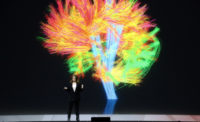This morning, after a marathon night of celebrations across Philadelphia, architects (caffeine at the ready) assembled for Day Two of the 2016 AIA convention.
The first order of business was the launch of the AIA’s second-annual “I Look Up” short film contest, part of the organization’s ongoing public awareness campaign. This year’s theme is “Architectural Solutions,” and the competition was kicked off with the screening of a documentary about Rural Studio, a design-build program that works with people in Hale County, Alabama, on community architecture projects.
“Let’s shine a light on these stories through the power of film,” AIA president Russell Davidson said. Winning shorts will be screened at the Architecture and Design Film Festival in New York and SXSW Eco Conference in Austin.
Next, several architects took the stage to receive their 2016 Honor Awards. Architect R. Steven Lewis received the 2016 Whitney M. Young Jr. Award, which honors contributions toward social justice issues. San Francisco-based firm EHDD received the Twenty-Five Year Award for its 1984 Monterey Bay Aquarium, located on the city’s historic Cannery Row.
Even architects who didn’t receive an Honor Award will soon be able to purchase their very own: The AIA announced that it is partnering with the U.S. Mint for a special-edition gold “investment coin” printed with the AIA’s Gold Medal insignia (Davidson joked that in spite of the partnership with the Mint, AIA members won’t able to print money directly).
For the day’s keynote address, MIT professor and founder of the pioneering research group Mediated Matter, Neri Oxman took the stage. “I live in a strange world called the MIT Media Lab,” she said. “I can offer you a view into what the future might look like.”
To Oxman, the future is one in which biology, computational design, and robotics will collide with architecture. She flicked through a slideshow presentation of her lab’s strange and fantastic design projects: a death mask shaped by the wearer’s final breath (“a biological urn”); a pavilion woven by an army of silk worms; an intestine-like wearable device that converts light into sucrose.
Oxman and her team are researching ways to design structures as continuous material systems, not assemblages of discrete parts. For one project, the researchers investigated the properties of chitin—the stiff, naturally-occurring material that makes up the exoskeletons of insects and arthropods. Using chitosan (derived from shrimp shells) and cellulose as “ink”, the lab 3-D printed lacy, 12-foot long structures. If sufficiently scaled, Oxman sees this technique as the future of construction. While exoskeleton skyscrapers may be a few years off, the audience was energized by Oxman’s vision of what lies ahead; she received a standing ovation














Post a comment to this article
Report Abusive Comment